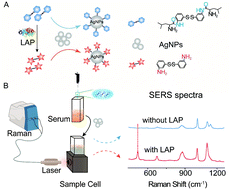Detection of leucine aminopeptidase activity in serum using surface-enhanced Raman spectroscopy†
Abstract
Leucine aminopeptidase (LAP), an important proteolytic enzyme, is closely associated with diverse physiological and pathological disorders such as liver injury and cancers. Hence, it is imperative to develop an effective method to detect LAP activity for early diagnosis of diseases. In this work, we report a novel SERS probe bis-s-s′-[(s)-2-amino-N-(3-thiophenyl)-Leu]. (b-(s)-ANT-Leu) with an L-leucine amide group, which can specially respond to LAP, to assay the LAP activity according to the SERS spectral changes between the probe molecule and its corresponding hydrolysis product resulting from the catalysis of LAP. This SERS approach features high selectivity on account of the specificity of the reaction combined with the instinctive fingerprinting ability of SERS and shows a good linear relationship in a wide range from 0.2 to 100 mU mL−1 with a detection limit as low as 0.16 mU mL−1. In addition, the SERS-based strategy can be competent for LAP activity detection in clinical patient serum samples and LAP inhibitor evaluation, demonstrating its great potential in the pathological analysis for diseases involving LAP and the screening of LAP inhibitors.

- This article is part of the themed collection: Clinical spectroscopy


 Please wait while we load your content...
Please wait while we load your content...